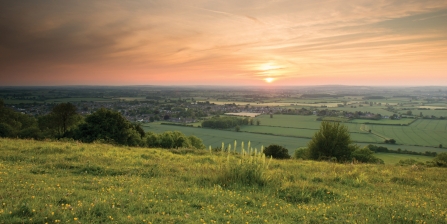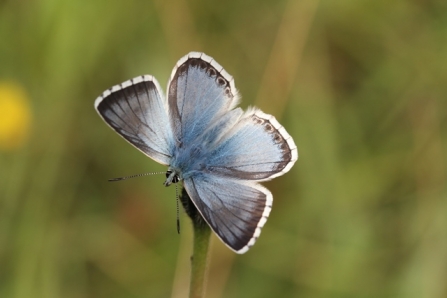
Wild flowers at Asham Meads. Photo by Colin Williams
Grangelands nature reserve by Rob Lewis

Wild flowers at Asham Meads. Photo by Colin Williams
These lovely expanses of Oxfordshire grasslands, near Otmoor, harbour rare mixes of national and local botanical gems. Asham Meads - probably named after the lost Otmoor village of Nash - is made up of three damp meadows (Upper Marsh - no public access, Lower Marsh and Rowbottom), an oak plantation which dates from the 1930s, a pond, hedges and scrub.
The meadows were once ploughed into ridges and furrows giving distinctive strips of colour from the different plants that prefer the wetter and drier areas. The flowers and hedgerows attract a host of butterflies including marbled white and black and brown hairstreak.
Plan your visit before the middle of the month to see the wild flowers before our annual hay cut, and check the 'getting there' information carefully to help you find the small car park. Once there, the ground is uneven underfoot and there are kissing gates.

View from Chinnor Hill. Photo by Paul Martin
With magnificent views over the Vale of Aylesbury, Chinnor Hill is a patchwork of flowery grassland, scrub and woodland, steeped in ancient history. The chalk grassland here contains an amazing variety of flowers including several species of orchids.
Chinnor Hill is also a great place to watch red kites soaring in the sky, as well as kestrels hovering above the slopes looking for prey, or just somewhere to sit and take in the view.
The site is sloping and steep and stony in places. There are rest benches, and wheelchair and mobility vehicle users can gain access to top of reserve with a RADAR key.

Chalkhill blue by Colin Williams
This nature reserve is known for its rich mix of chalk downland plants. The summer is the time to see the impressive display of wild orchids across the site. Pyramidal, chalk fragrant-, common spotted- and bee orchids are all found here.
In the summer common blue, marbled white and chalkhill blue butterflies are all found here too. The chalkhill blue is limited to this type of habitat as it lays its eggs only on horseshoe vetch. It is our second largest blue butterfly and the males can be seen flying low over the vegetation.
The reserve is sloping and steep in places. Access includes kissing gates and some stiles. The Ridgeway National Trail passes through the reserve making it ideal to include as part of a longer walk through the area.
Discover more about the reserve and its butterflies on our guided walk later in the summer.

River Pang, Moor Copse by Clive Ormonde
This diverse woodland wildlife treasure trove astride the River Pang is a haven of peace and beauty, renowned for its flowers, butterflies and moths. In summer, butterflies are abundant, including the handsome silver-washed fritillary whose larvae feed on violets.
Dragonflies and damselflies, such as the beautiful demoiselle and the brown hawker hunt up and down the river. The shady woodlands provide an escape from hot, sunny days. The meadow is cut later in the month so don't leave it too late to visit to see the flowers at their best.
The ground is mostly flat but can flood. There are some cross slopes and coarse aggregates on paths, and access includes gates.

Rushbeds Wood by Phil Townsend
Discover a wealth of wild flowers and butterflies in this ancient woodland and meadows. Rushbeds Wood is excellent for butterflies, and you are likely to see the tree canopy aflutter with the fast-flying purple hairstreak in June and July.
The wood also supports some of the more uncommon butterflies such as the purple emperor and the black hairstreak. If you are lucky, you might catch a glimpse of the handsome silver-washed fritillary settling on bramble flowers, or even a white admiral.
Please stick to the paths to avoid trampling the wild flowers along the woodland rides. Make sure to visit before the meadows are cut later in the month.
The paths are mainly flat but access includes gates. There are rest benches.

Marbled White (Melanagria galathea) resting on Small Scabious (Scabiosa colombaria) by Guy Edwardes/2020VISION
Nationally important for its archaeology as well as its wildlife, this ancient and atmospheric site has a wonderful variety of chalk grassland flowers and butterflies. More than 150 plant species have been recorded on this old chalk grassland including horseshoe vetch, chalk milkwort, chalk fragrant-orchid, the delicate blue harebell and the purple-blue clustered bellflower. Its notable butterfly list includes the chalkhill blue, small blue, brown argus, marbled white and small heath.
Access is mostly flat but can be uneven in places.